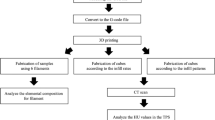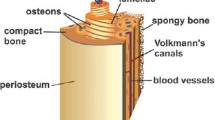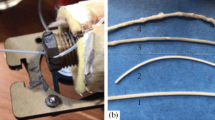Abstract
Additive manufacturing has become increasingly useful for the development of biomedical devices. Particularly, medical and dental studies have benefited from anthropomorphic simulators (phantoms) that can be 3D-printed using materials with radiopaque properties similar to human tissues. Among the various 3D printing techniques, material extrusion has gained significant attention due to its simplicity and cost-effectiveness. This study aimed to develop PLA (polylactic acid) composite filaments by incorporating natural hydroxyapatite, aluminum oxide, and zirconium oxide. These composites underwent thermal, morphological, and mechanical characterization, and their intensity in computed tomography was compared with that of human tissues. The zirconium oxide composites exhibited a maximum value of 184 Hounsfield Unit (HU), closely mimicking cortical bone, with a mere 6% weight fraction of ZrO\(_{2}\). Conversely, natural hydroxyapatite and aluminum oxide did not demonstrate any significant improvements over pure polymers for soft tissue applications. The influence of porosity on printed components was observed to decrease mechanical properties and X-ray intensity. The use of stearic acid as a surfactant helped to improve the distribution of ceramic powder within the polymer matrix. This resulted in better fluidity of the composites, facilitating successful 3D printing using the filament extrusion process. Overall, the results suggest that the newly developed PLA-based zirconia composite filament can be utilized to mimic cortical bone in anthropomorphic simulators for use in medical and dental studies.








Similar content being viewed by others
Data availability
The data that support the findings of this study are available on request from the corresponding author.
References
Akindoyo JO, Beg MDH, Ghazali S et al (2018) Impact modified PLA-hydroxyapatite composites - thermo-mechanical properties. Compos Part A-Appl S 107:326–333. https://doi.org/10.1016/J.COMPOSITESA.2018.01.017
Arnold J, Sarkar K, Smith D (2021) 3D printed bismuth oxide-polylactic acid composites for radio-mimetic computed tomography spine phantoms. J Biomed Mater Res 109:789–796. https://doi.org/10.1002/jbm.b.34744
Askari M, Hutchins DA, Thomas PJ, et al (2020) Additive manufacturing of metamaterials: a review. additive manufacturing. Addit Manuf 36. https://doi.org/10.1016/j.addma.2020.101562
ASTM International (2022) D 638-22 standard test method for tensile properties of plastics. ASTM pp 16. https://doi.org/10.1520/D0638-22
Baltazar J, Torres PMC, Dias-de Oliveira J et al (2021) Influence of filament patterning in structural properties of dense alumina ceramics printed by robocasting. J Manuf Process 68:569–582. https://doi.org/10.1016/j.jmapro.2021.05.043
Bazalova M, Carrier JF, Beaulieu L et al (2008) Dual-energy CT-based material extraction for tissue segmentation in monte carlo dose calculations. Phys Med Biol 53. https://doi.org/10.1088/0031-9155/53/9/015
Berger MJ, Hubell JH, Seltzer SM, et al. (2010) Xcom: photon cross section database, version 1.5. NIST
Brackett J, Cauthen D, Condon J et al (2022) The impact of infill percentage and layer height in small-scale material extrusion on porosity and tensile properties. Addit Manuf 58:103063. https://doi.org/10.1016/J.ADDMA.2022.103063
Calafel I, Aguirresarobe RH, Peñas MI, et al. (2020) Searching for rheological conditions for FFF 3D printing with PVC based flexible compounds. Materials 13:178. https://doi.org/10.3390/ma13010178
Cano S, Gonzalez-Gutierrez J, Sapkota J et al (2019) Additive manufacturing of zirconia parts by fused filament fabrication and solvent debinding: selection of binder formulation. Addit Manuf 26:117–128. https://doi.org/10.1016/J.ADDMA.2019.01.001
Cloonan AJ, Shahmirzadi D, Li RX, et al. (2014) 3D-printed tissue-mimicking phantoms for medical imaging and computational validation applications. 3D Print Addit Manuf 1:14–27. https://doi.org/10.1089/3dp.2013.0010
Cojocaru V, Frunzaverde D, C-OM, et al. (2022) The influence of the process parameters on the mechanical properties of PLA specimens produced by fused filament fabrication-a review. Polymers 14(5):886. https://doi.org/10.3390/polym14050886
Darling CJ, Curtis C, Sciacca BJ et al (2022) Fused filament fabrication of complex anatomical phantoms with infill-tunable image contrast. Addit Manuf 52. https://doi.org/10.1016/j.addma.2022.102695
Del-Mazo-Barbara L, Ginebra MP (2021) Rheological characterisation of ceramic inks for 3D direct ink writing: a review. J Eur Ceram Soc 41:18–33. https://doi.org/10.1016/j.jeurceramsoc.2021.08.031
Faccio M, Thomazi E, Silva LR et al (2021) Efeito do ácido esteárico em scaffolds de alumina obtidos por manufatura aditiva usando o método de fabricação por filamento fundido. Cerâmica 67:486–497. https://doi.org/10.1590/0366-69132021673843182
Fenyo-Pereira M (ed) (2013) Radiologia Odontológica e, Imaginologia. Santos, São Paulo
Filippou V, Tsoumpas C (2018) Recent advances on the development of phantoms using 3D printing for imaging with CT, MRI, PET, SPECT, and ultrasound. Med Phys 45:740–760. https://doi.org/10.1002/mp.13058
Finke B, Hesselbach J, Schütt A et al (2020) Influence of formulation parameters on the freeform extrusion process of ceramic pastes and resulting product properties. Addit Manuf 32. https://doi.org/10.1016/j.addma.2019.101005
Francis V, Jain PK (2016) Experimental investigations on fused deposition modelling of polymer-layered silicate nanocomposite. Virtual Phys Protot 11:109–121. https://doi.org/10.1080/17452759.2016.1172431
Geng P, Zhao J, Wu W et al (2019) Effects of extrusion speed and printing speed on the 3d printing stability of extruded peek filament. J Manuf Process 37:266–273. https://doi.org/10.1016/j.jmapro.2018.11.023
Gibson I, Rosen D, Stucker B (2015) Additive manufacturing technologies: 3D printing, rapid prototyping, and direct digital manufacturing. Springer, New York
Gorjan L, Galusca C, Sami M et al. (2020) Effect of stearic acid on rheological properties and printability of ethylene vinyl acetate based feedstocks for fused filament fabrication of alumina. Addit Manuf 36. https://doi.org/10.1016/j.addma.2020.101391
Hasib AG, Niauzorau S, Xu W et al. (2021) Rheology scaling of spherical metal powders dispersed in thermoplastics and its correlation to the extrudability of filaments for 3D printing. Addit Manuf 41. https://doi.org/10.1016/j.addma.2021.101967
Higgins M, Leung S, Radacsi N (2022) 3D printing surgical phantoms and their role in the visualization of medical procedures. Annal3D Print Med 6. https://doi.org/10.1016/j.stlm.2022.100057
Hnatkova E, Hausnerova B, & Filip P (2019) Evaluation of powder loading and flow properties of Al\(_{2}\)O\(_{3}\) ceramic injection molding feedstocks treated with stearic acid. Ceram Int 45. https://doi.org/10.1016/J.CERAMINT.2019.06.273
Hong D, Lee S, Kim GB, et al. (2020) Development of a CT imaging phantom of anthromorphic lung using fused deposition modeling 3D printing. Medicine (US) 99:8. https://doi.org/10.1097/MD.0000000000018617
Hubbell J, Seltzer S (2004) X-ray mass attenuation coefficients. NIST Standard Reference Database. https://doi.org/10.18434/T48G6X
Huda W, Scalzetti EM, Levin G (2000) Technique factors and image quality as functions of patient weight at abdominal CT. Radiology 217:430–435. https://doi.org/10.1148/radiology.217.2.r00nv35430
Ikram H, al Rashid A, Koç M (2022) Additive manufacturing of smart polymeric composites: Literature review and future perspectives. Polym Compos 43:6355–6380. https://doi.org/10.1002/PC.26948
Irnstorfer N, Unger E, Hojreh A et al (2019) An anthropomorphic phantom representing a prematurely born neonate for digital x-ray imaging using 3D printing: proof of concept and comparison of image quality from different systems. Sci Rep 9:1–12. https://doi.org/10.1038/s41598-019-50925-3
Ivanova R, Kotsilkova R (2018) Rheological study of poly(lactic) acid nanocomposites with carbon nanotubes and graphene additives as a tool for materials characterization for 3d printing application. Appl Rheol 28. https://doi.org/10.3933/ApplRheol-28-54014
Kim JS, Lee CS, Lee SW et al (2020) Fabrication and characterization of hollow glass beads-filled thermoplastic composite filament developed for material extrusion additive manufacturing. J Compos Mater 54:607–615. https://doi.org/10.1177/0021998319863836
Lim S, Kathuria H, Tan J et al (2018) 3d printed drug delivery and testing systems - a passing fad or the future? Adv Drug Deliver Rev 132:139–168. https://doi.org/10.1016/j.addr.2018.05.006
Murali A, Vakkattil M, Parameswaran R (2023) Investigating the effect of processing parameters on mechanical behavior of 3d fused deposition modeling printed polylactic acid. J Mater Eng Perform 32:1089–1102. https://doi.org/10.1007/s11665-022-07188-3
Murariu M, Dubois P (2016) PLA composites: from production to properties. Adv Drug Deliver Rev 107:17–46. https://doi.org/10.1016/J.ADDR.2016.04.003
Oenning AC, Salmon B, de Faria Vasconcelos K et al. (2018) DIMITRA paediatric skull phantoms: development of age-specific paediatric models for dentomaxillofacial radiology research. Dentomaxillofac Rad 47. https://doi.org/10.1259/dmfr.20170285
Oh SA, Kim MJ, Kang JS, et al. (2017) Feasibility of fabricating variable density phantoms using 3D printing for quality assurance (QA) in radiotherapy. Prog Med Phys 28:106–110. https://doi.org/10.14316/PMP.2017.28.3.106
Parthasarathy J, Krishnamurthy R, Ostendorf A et al (2020) 3D printing with MRI in pediatric applications. J Magn Reson Imaging 51:1641–1658. https://doi.org/10.1002/jmri.26870
Peng E, Zhang D, Ding J (2018) Ceramic robocasting: recent achievements, potential, and future developments. Advanced Materials 30. https://doi.org/10.1002/adma.201802404
Penumakala PK, Santo J, Thomas A (2020) A critical review on the fused deposition modeling of thermoplastic polymer composites. Compos Part B-Eng 201. https://doi.org/10.1002/10.1016/j.compositesb.2020.108336
Pereira FM, Canevarolo SV, Chinelatto MA (2019) Isothermal crystallization kinetics of biodegradable poly(lactic acid)/poly(\(\epsilon \)-caprolactone) blends compatibilized with low-molecular weight block copolymers. Polym Eng Sci 59:161–169. https://doi.org/10.1002/PEN.25019
Phan DD, Swain ZR, Mackay ME (2018) Rheological and heat transfer effects in fused filament fabrication. J Rheol 62:1097–1107. https://doi.org/10.1122/1.5022982
Rajan K, Samykano M, Kadirgama K et al (2022) Fused deposition modeling: process, materials, parameters, properties, and applications. Int J Adv Manuf Tech 120:1531–1570. https://doi.org/10.1007/s00170-022-08860-7
Ramkumar P, Rijwani T (2022) Additive manufacturing of metals and ceramics using hybrid fused filament fabrication. J Braz Soc Mech Sci Eng 44:455. https://doi.org/10.1007/s40430-022-03762-x
Ricotti R, Ciardo D, Pansini F et al (2017) Dosimetric characterization of 3d printed bolus at different infill percentage for external photon beam radiotherapy. Phys Med 39:25–32. https://doi.org/10.1016/j.ejmp.2017.06.004
Roque R, Barbosa GF, Guastaldi AC (2021) Design and 3D bioprinting of interconnected porous scaffolds for bone regeneration. an additive manufacturing approach. J Manuf Process 64:655–663. https://doi.org/10.1016/J.JMAPRO.2021.01.057
Rueda MM, Auscher MC, Fulchiron R et al (2017) Rheology and applications of highly filled polymers: a review of current understanding. Prog Polym Sci 66:22–53. https://doi.org/10.1016/j.progpolymsci.2016.12.007
Santana L, Alves JL, Sabino Netto AdC et al. (2018) Estudo comparativo entre PETG e PLA para impressão 3D através de caracterização térmica, química e mecânica. Materia-Brazil 23. https://doi.org/10.1590/S1517-707620180004.0601
Scaffaro R, Citarrella M, Catania A et al (2022) Green composites based on biodegradable polymers and anchovy (engraulis encrasicolus) waste suitable for 3d printing applications. Compos Sci Technol 230:109768. https://doi.org/10.1016/j.compscitech.2022.109768
Shaikh SS, Nahar P, Shaikh SY, et al. (2021) Current perspectives of 3D printing in dental applications. Braz Dental Sci 24. https://doi.org/10.14295/bds.2021.v24i3.2481
Shin J, Sandhu RS, Shih G (2017) Imaging properties of 3D printed materials: multi-energy CT of filament polymers. J Digit Imaging 30:572–575. https://doi.org/10.1007/s10278-017-9954-9
Sinha R, Sanchez A, Camara-Torres M et al (2021) Additive manufactured scaffolds for bone tissue engineering: physical characterization of thermoplastic composites with functional fillers. ACS Appl Polym Mater 3:3788–3799. https://doi.org/10.1021/acsapm.1c00363
Solc J, Vrba T, Burianova L (2018) Tissue-equivalence of 3D-printed plastics for medical phantoms in radiology. Journal of Instrumentation 13. https://doi.org/10.1088/1748-0221/13/09/P09018
Tack P, Victor J, Gemmel P et al. (2016) 3D-printing techniques in a medical setting: a systematic literature review. Biomed Eng Online 15. https://doi.org/10.1186/S12938-016-0236-4
Vanaei H, Shirinbayan M, Deligant M et al (2020) Influence of process parameters on thermal and mechanical properties of polylactic acid fabricated by fused filament fabrication. Polym Eng Sci 60(8):1822–1831. https://doi.org/10.1002/PEN.25419
Vogiatzi T, Menz R, Verna C et al. (2022) Effect of field of view (FOV) positioning and shielding on radiation dose in paediatric CBCT. Dentomaxillofac Rad 51. https://doi.org/10.1259/dmfr.20210316
Weng Z, Wang J, Senthil T et al (2016) Mechanical and thermal properties of ABS/montmorillonite nanocomposites for fused deposition modeling 3d printing. Mater Design 102:276–283. https://doi.org/10.1016/J.MATDES.2016.04.045
Wood S, Martins T, Ibrahim TS (2019) How to design and construct a 3D-printed human head phantom. J 3D Print Med 3:119–125. https://doi.org/10.2217/3dp-2019-0016
Yadav A, Rohru P, Babbar RA Kumar, et al. (2022) Fused filament fabrication: a state-of-the-art review of the technology, materials, properties and defects. Int J Interac Design Manuf pp 1955–2505. https://doi.org/10.1007/s12008-022-01026-5
Yi Z, Yang J, Liu X, et al. (2020) Enhanced mechanical properties of poly(lactic acid) composites with ultrathin nanosheets of mxene modified by stearic acid. J Appl Polym Sci 137. https://doi.org/10.1002/APP.48621
Zhu Y, Joralmon D, Shan W et al (2021) 3D printing biomimetic materials and structures for biomedical applications. Bio-Design Manuf 4:405–428. https://doi.org/10.1007/S42242-020-00117-0
Čelko L, Gutiérrez-Cano V, Casas-Luna M, et al. (2021) Characterization of porosity and hollow defects in ceramic objects built by extrusion additive manufacturing. Addit Manuf 47. https://doi.org/10.1016/j.addma.2021.102272
Acknowledgements
The support from the Brazilian Government Agencies Conselho Nacional de Desenvolvimento Científico e Tecnológico (CNPq)-grants 305528/2018-1 and 305253/2018-2, Programa de Apoio a Núcleos de Excelência (PRONEX), Fundação de Amparo á Pesquisa do Estado do Rio Grande do Sul (FAPERGS), Instituto Federal de Educação, Ciência e Technologia do Rio Grande do Sul (IFRS), and Universidade de Caxias do Sul (UCS) is gratefully acknowledged. This study was also financed in part by the Coordenação de Aperfeiççoamento de Pessoal de Nível Superior-Brasil (CAPES), Finance Code 001 and Financiadora de Estudos e Projetos (FINEP). The authors would like to thank the Laboratório Central de Microscopia (LCMIC), Laboratório de Polímeros (LPol) da Universidade de Caxias do Sul, and Setor de Radiologia do Hospital Geral de Caxias do Sul. Thanks are also due to the Laboratório de Caracterização de Materiais Poliméricos do Instituto Federal do Rio Grande do Sul, Campus Caxias do Sul.
Author information
Authors and Affiliations
Contributions
Conceptualization and methodology: E.T., C.A.P., and J.E.Z.; data curation and investigation: E.T., C.R.Jr., and T.O.G.; writing (original draft preparation): E.T.; writing (review and editing): E.T., C.R.Jr., T.O.G., C.A.P., and J.E.Z. All authors have read and agreed to the published version of the manuscript.
Corresponding author
Ethics declarations
Conflict of interest
The authors declare no competing interests.
Additional information
Publisher's Note
Springer Nature remains neutral with regard to jurisdictional claims in published maps and institutional affiliations.
Rights and permissions
Springer Nature or its licensor (e.g. a society or other partner) holds exclusive rights to this article under a publishing agreement with the author(s) or other rightsholder(s); author self-archiving of the accepted manuscript version of this article is solely governed by the terms of such publishing agreement and applicable law.
About this article
Cite this article
Thomazi, E., Roman, C., Gamba, T.O. et al. PLA-based ceramic composites for 3D printing of anthropomorphic simulators. Int J Adv Manuf Technol 128, 5289–5300 (2023). https://doi.org/10.1007/s00170-023-12206-2
Received:
Accepted:
Published:
Issue Date:
DOI: https://doi.org/10.1007/s00170-023-12206-2




